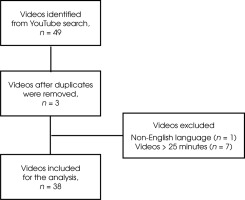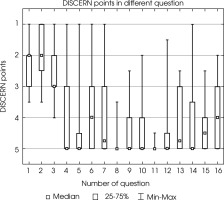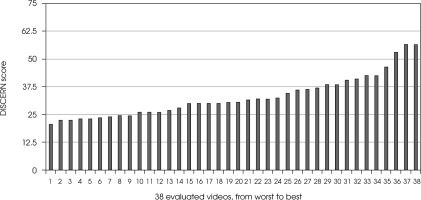INTRODUCTION
Health information, patient support, and treatment recommendations are increasingly available through online social media and entertainment platforms [1, 2]. It is believed that about 80% of adult internet users search for health information online [3]. One of the most popular websites on which such information is shared is You-Tube. Since its establishment in 2005, YouTube has been visited by over 2 billion users per month, and more than 500 hours of content is uploaded every minute [4]. This can be one of the primary sources of data for patients to learn about their condition, which was especially the case during the COVID-19 pandemic. However, due to YouTube’s open character, much of this content is unregulated and often inaccurate. Therefore, it is important to assess the value, suitability, and sufficiency of the medical material available on the platform. To the best of our knowledge, the data on YouTube connected with body dysmorphic disorder (BDD) has not been previously investigated.
BDD, also known as dysmorphophobia, is a mental condition classified by both DSM-5 and ICD-11 as obsessive-compulsive and related disorders [5, 6]. BDD is characterized by a preoccupation with a non-existing or minimal defect in appearance, which usually involves skin, hair, weight, stomach, teeth, or genitals [7, 8]. It is accompanied by the performance of repetitive behaviors such as camouflaging the flaw, mirror checking, or excessive grooming and leads to distress in many areas of functioning [5, 8]. The prevalence of BDD is estimated at around 2%, although the occurrence of this disorder and its features is higher among dermatology and cosmetic medicine patients [9-12]. This disorder is associated with other psychiatric conditions such as mood or anxiety disorders [7]. The main treatment includes selective serotonin reuptake inhibitors (SSRIs) and cognitive-behavioral therapy [13].
Our study aimed to evaluate the usefulness and the quality of the most viewed videos regarding body dysmorphic disorder on YouTube. By using validated instruments, we intended to discover the most informative videos regarding BDD that might be used in the education of patients and their families.
METHODS
Search strategy and data collection
A YouTube search for the keywords “body dysmorphic disorder” and “dysmorphophobia” was conducted between February and April 2022. We analyzed videos uploaded between the years 2012 and 2021, according to YouTube’s default “most viewed” sorting. The Google Chrome browser was used in “Incognito Mode” without being logged in to any social media account to avoid personalization of the results. No approval from an ethics committee or YouTube was required because all of the research data were available to the public and the study did not include involvement from humans or animals.
Inclusion and exclusion criteria
All of the videos searched and sorted by “most viewed” criteria; those with more than 20,000 views were taken into consideration. Of these, videos longer than 25-minutes, non-English videos, duplicate videos, and irrelevant videos were excluded. The remaining videos were included for a thorough investigation. Since the DISCERN instrument was created in response to the need for a comprehensive set of quality standards for written consumer health information on treatment choices, and as it is directly mentioned in the general instructions of DISCERN instrument, we included videos regarding information about BDD treatment.
Variables extracted
Data collected for each video included: video URL, duration (minutes), year of upload, days since upload date, the number of views, likes, comments, the inclusion of diagrams, results of treatment, and type of treatment. The videos were classified according to the source: healthcare and non-healthcare.
Scoring system
We evaluated the videos for the following outcomes: quality, popularity, and viewer engagement. All videos were assessed independently by two raters, a dermatologist and a psychiatrist with over 25 years of experience, both medically trained about BDD.
For video quality the assessment validated DISCERN instrument and the Global Quality Score (GQS) were applied (Tables 1 and 2). DISCERN was created by a group of specialists to help health consumers and information providers assess the quality of written information about treatment choices (e.g., conventional, complementary, psychological) for health problems. The DISCERN Project was based at the University of Oxford, Division of Public Health and Primary Health Care, at the Institute of Health Sciences, which later became the Nuffield Department of Population Health and the Nuffield Department of Primary Care Health Sciences. The detailed process of creating the scale has been described in the study by Charnock et al. [13]. It contains 16 questions that assess the clarity, balance, and content of information in any particular publication on a scale of 1 to 5, with 1 indicating that the criteria have not been fulfilled at all, and 5 being that they are entirely fulfilled. The first eight questions concern reliability, the following seven are about treatment information, and the last question is on overall quality. The DISCERN scoring system categorizes objects using a 15-75-point scale, with scores classified as follows: excellent is denoted by scores ranging from 63 to 75 points, good is denoted by scores of 51 to 62 points, fair is denoted by scores of 39 to 50 points, poor is denoted by scores of 27 to 38 points, and very poor is denoted by scores of 16 to 26 points.
Table 1
DISCERN quality scoring system
Table 2
Global Quality Score criteria
The GQS is an unvalidated but widely used scale for evaluating the quality of internet resources. It allows users to assess the overall quality of a video’s content on a five-point Likert scale. The GQS has a maximum score of 5, indicating that the flow and educational quality is excellent, whereas a score of 1 point indicates the poorest quality.
To evaluate the popularity of each video the Video Power Index (VPI) score was used. The VPI was previously calculated as follows: like ratio*view ratio/100, the like ratio was defined as (like*100/[like+dislike]), and the view ratio was defined as (number of views/days) [11, 12]. However since dislikes are no longer shown on the platform, we modified the like ratio from (like*100/[like+dislike]) to only the number of likes.
Viewer engagement was measured using an engagement ratio, which was described in previous research as the sum of the number of likes, dislikes, and comments divided by the total number of views [14].
Statistical methods
The collected data was analyzed with the Statistica 13 software using the ANOVA Kruskal-Wallis test, the U Mann-Whitney test, and Spearman’s rank correlation time coefficient test. A p-value less than 0.05 was considered statistically significant. Microsoft Excel 2019 and Microsoft Word 2019 were used for the preparation of figures.
RESULTS
Video statistics
Out of the 49 videos analyzed, we excluded 11 for the following reasons: 7 were longer than 25-minutes, 3 were duplicated, and 1 was a non-English video. In consequence, a total of 38 videos were assessed (Figure I). The overall statistics concerning viewer interaction were measured: the total view count was 12,741,214 (mean, 344,357; range, 8,455-2,734,582). The following are the mean and range for all the quantitative video metrics for all the videos analyzed: number of likes (mean, 7,238; range, 57-66,000), number of comments (mean, 763; range, 3-4,478), total duration of all videos 4 h 24 min. 52 sec. (mean, 7 min. 9 sec.; range, 1 min. 37 sec – 17 min. 10 sec.) (Table 3).
Table 3
Total video statistics and mean scores
Video upload source
Only 9/38 (23.7%) were uploaded by a healthcare source (medical doctor, hospital, private medical clinic); most, 29/38 (76.3%), came from non-healthcare sources.
Video quality evaluation – DISCERN and GQS score
The two individual raters had a DISCERN score of 31.97 ± 9.22 (range, 20-57) and 33.82 ± 9.42 (range, 21-58), respectively. The mean DISCERN score between the raters was 32.89 ± 9.23 (range, 20.5-56.5). The intraclass correlation coefficient for the absolute agreement was 0.96 between the 2 reviewers, which is regarded as excellent reliability. The mean score of question 16 of DISCERN (which demands a comprehensive assessment of the entire video) was 2.21. The median scores for questions 1-15 are presented in Figure II. The summary of the DISCERN score is presented in Figure III.
A GQS score, as obtained by two individual raters, was 2.82 ± 0.97 (range, 1-5) and 2.87 ± 1.08 (range, 1-5), respectively. The mean GQS score between the raters was 2.84 ± 1.03 (range, 1-5). The intraclass correlation coefficient for the absolute agreement was 0.91 between the 2 reviewers, which is considered excellent accuracy.
The correlation between DISCERN Score and GQS score was 0.81 (p < 0.00001), assessed using Spearman’s rank correlation time coefficient test. There was a significant difference between DISCERN scores depending on the source of the video: healthcare – 42 mean vs. non-healthcare – 30.07 mean (p = 0.0035). Healthcare source videos had notably higher DISCERN results on 8 questions compared to non-healthcare source videos. Moreover, healthcare source videos had notably higher GQS scores than the others: a 3.83 mean vs. a 2.53 mean (p = 0.000559).
Video popularity evaluation – Video Power Index
The mean score for the VPI was 2757 (range, 244,57-11647.12). There was no difference between VPI and video upload source.
There was no significant correlation between the DISCERN, GQS, and VPI, the number of views, likes, dislikes, comments, and video duration.
Top-quality videos
In our study, from the 3 top-rated dysmorphophobia videos, based on the DISCERN criteria, 2 came from a healthcare source and 1 from a non-healthcare one. Each of the videos had a DISCERN score over 53, and the highest DISCERN score was achieved by the videos from psychiatrist Dr. Tracey Marks and McMaster Demystifying Medicine, both with 56.5 (Table 4). According to the DISCERN scoring system, these videos are categorized as good materials; however, none of the reviewed videos obtained a score of 63 or more, which allows for the definition of a video as excellent.
Table 4
The top 3 quality body dysmorphic disorder videos based on the DISCERN criteria
DISCUSSION
Considering the results of the study in which only 3 videos were rated as good quality and the rest 35 as fair, poor, or very poor, the information related to BDD seems to be insufficient.
There are only a small number of references in the literature on assessing mental disorder content on Youtube. Contrary to our research, Szmuda et al. rated the quality of the content on bipolar disorder (BD) on YouTube as good. In addition, the results of our research showed contradictory beliefs about the correlation of content from healthcare sources with average daily viewership, commentary, and video power index, which was significant concerning the topic of BD [15]. This correlation often varies among the research conducted, which may arise from not using validated statistical methods (video power index, number of viewers, or commentary) or, indeed, differences in the content of different topics.
In the content related to BDD, as we have seen significantly fewer videos on YouTube are published by a healthcare source (23.7%) than a non-healthcare one (76.3%). This tendency differs in the literature depending on the subject matter studied [16-18]. Moreover, in our study the content published by medical sources was of notably better quality, which was also noticed in several other pieces of research [19-22]. This shows that physicians or healthcare organizations should publish more medical content on YouTube, increasing the amount of more reliable and informative content for patients.
What is more, the fact that there were no correlations between the quality of a video quality and its popularity or patients’ engagement indicates that they may not differentiate between high- and low-quality videos, which was also noted in the study by Pamukcu et al. [23]. Taking an example from other scientific publications in our paper, we have included the URLs of the 3 most valuable videos regarding BDD in terms of quality. This may enable both doctors and patients find and use educational videos on YouTube with proper quality more easily.
Our study is the first to evaluate the quality of information about BDD on YouTube. Similar content was provided by Griffiths et al., who linked social media (including YouTube) and body dissatisfaction. That study found a significant correlation between YouTube usage and body dissatisfaction appearance among participants [24]. Due to the growing number of mental disorders and the interest in this subject among the public, there is a need to evaluate further topics in the field of psychiatry on social networks, thanks to which it will be possible to create better and more reliable content for patients.
BDD, in a proportion of subjects, manifests with dysfunctional thinking and cognitive distortions of the self-image as related to several psychosocial factors. Thus, in several cases the awareness of maladaptive strategies as distressing may be partial or absent, implicating the concept of appearance concerns other than BDD. In such cases of BDD with no or partial insight, the quality of educational material needs to be improved so as to initiate the concept of disproportion of bodily image perception as related to the concept of wellness [25].
However, none of the videos mentioned the topic of cognitive dysfunction in BDD. According to a previous study, patients with BDD presented with impaired cognitive flexibility, reward and motor impulsivity and affective processing compared to a healthy control group [26]. As research on this subject is relatively new, the implementation of this topic in BDD education should be considered.
LIMITATIONS
The present study is the first to use a validated instrument to evaluate the quality of YouTube videos on the medical management of BDD and has several limitations. Since we included only videos in English in our study, those in other languages may present a different quality. English, on the other hand, is widely regarded as the preferred language for obtaining information online. Nonetheless, it is worth noting that from all videos with more than 25,000 views only one video was not in English, which is unquestionably a small percentage. Another limitation is the fact that our research excluded videos that were more than 25 minutes long and some variables were assessed without the use of validated instruments.
Moreover, there is the substantial impact of variability regarding residual self-image as related to gender, culture, socioeconomic status and geography. This study was based on a population willing to use social media platforms and suffering from BDD distress.
CONCLUSIONS
The videos reviewed videos revealed that although YouTube viewers have a fair amount of interest in dysmorphophobia, the content that is being offered to them is of poor quality. Video statistics proved medical professionals may use YouTube to reach a large audience while also providing reliable and pertinent information on BDD, reducing the spread of misinformation. Practitioners should be involved in both the development and verification of material to raise the quality of videos.










